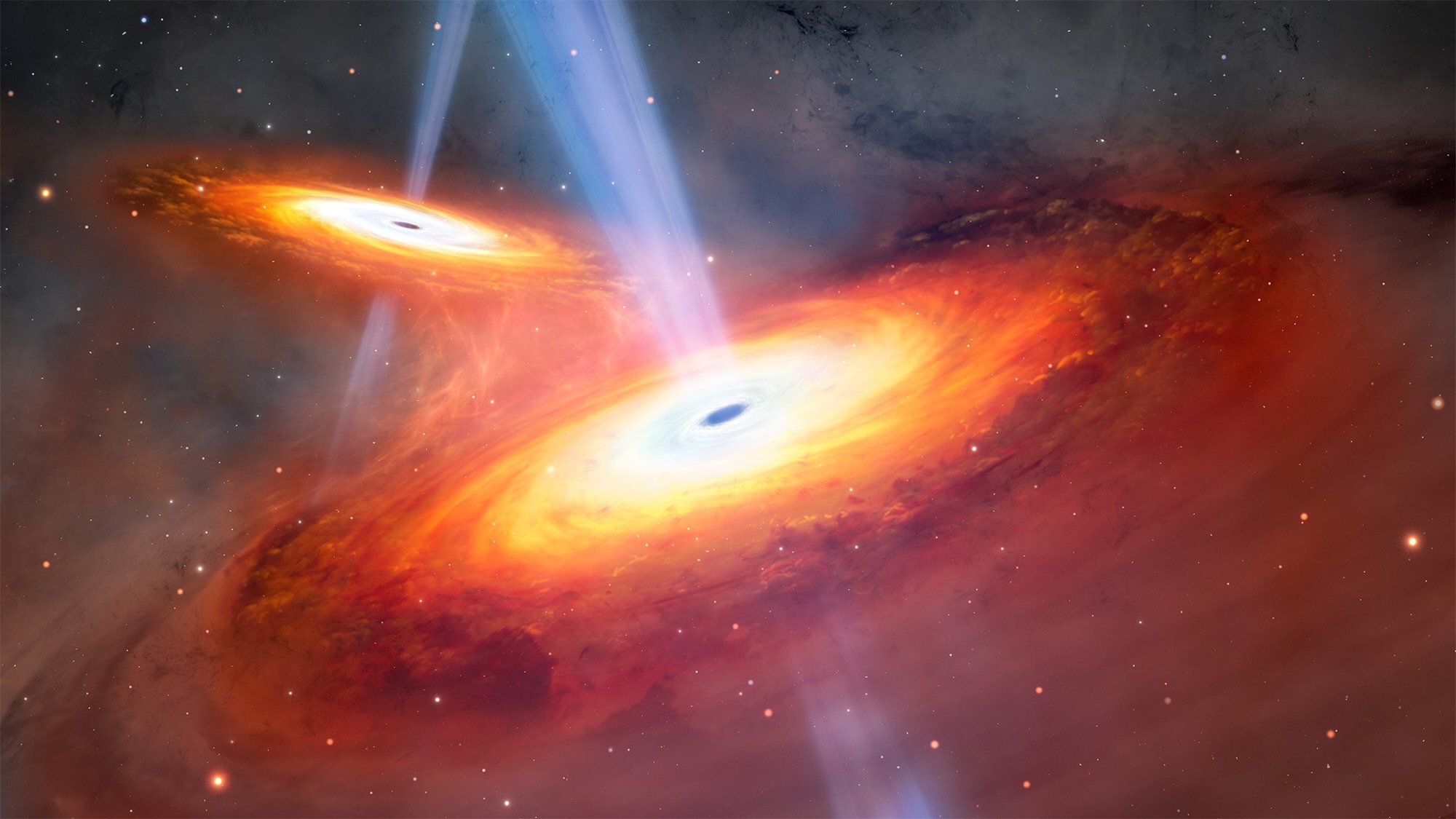

We may earn revenue from the products available on this page and participate in affiliate programs. Learn more ›
Despite the vastness of space, galaxies are still colliding, merging, and even overlapping. Now, an international team of astronomers have spotted the ´most distant pair of quasars ever found. These two galactic cores are merging with one another, with dust and gas falling into a central supermassive black hole. Like all quasars, the pair emits enormous amounts of light, but this dynamic duo dates all the way back to the Cosmic Dawn. The findings are described in a study published in The Astrophysical Journal Letters, and shed some light on these mysterious cosmic bodies.
What are quasars?
Our universe has been expanding for almost 14 billion years–since the first seconds after the big bang. Early on, it was much smaller and the galaxies that formed were more likely to interact and merge with each other.
[Related: Blindingly bright black holes could help cosmologists see deeper into the universe’s past.]
These galaxy mergers are the fuel behind quasars–extremely bright galactic cores, where gas and dust is falling into a supermassive black hole at the center. Despite the name, these giant central black holes emit huge amounts of light.
It would seem that when looking back in time at the early universe astronomers would find several pairs of quasars very close to each other, while their host galaxies are undergoing mergers. However, they haven’t found evidence of these merging galaxies in this time period until now.
What is the Epoch of Reionization?
In this new study, the team used data from the ground-based Gemini North telescope in Hawaii. They confirmed that a pair of quasars they spotted date back to the Cosmic Dawn–about 50 million to one billion years after the big bang. This is right around when stars and galaxies began appearing and a dark universe was filled with illumination for the first time.
Scientists call the roughly 400 million years after the big bang within the Cosmic Dawn when the cosmos formed the Epoch of Reionization. Ultraviolet light from the first stars, galaxies, and quasars spread out into the cosmos. The light also conducted a process called ionization–stripping electrons from the early universe’s hydrogen atoms.
According to astronomers, the Epoch of Reionization and all of its hydrogen-stripping was a critical epoch in the history of the universe. It marked the end of the cosmic dark ages and was the beginning of the large, brilliant structures that we can see from Earth today.
Seeing red
To better understand the exact role quasars played during the Epoch of Reionization, astronomers are searching for quasars in this early and distant era of the universe.
“The statistical properties of quasars in the Epoch of Reionization tell us many things, such as the progress and origin of the reionization, the formation of supermassive black holes during Cosmic Dawn, and the earliest evolution of the quasar host galaxies,” Yoshiki Matsuoka, a study co-author and an astronomer at Ehime University in Japan, said in a statement.
[Related: What we can learn from baby black holes.]
Previously, roughly 300 quasars have been discovered in the Epoch of Reionization, but none of them have come in a pair. There have been some other potential quasar duo candidates, but according to the team, it has been difficult to differentiate them from potential gravitational-lensing coming off of a single quasar.
When Matsuoka and the team were reviewing images taken with the Hyper Suprime-Cam on the Subaru Telescope, they noticed a faint bit of red.

“While screening images of quasar candidates I noticed two similarly and extremely red sources next to each other,” said Matsuoka. “The discovery was purely serendipitous.”
At first, the team was not entirely sure if they were seeing a quasar pair. Distant quasar candidates are typically contaminated by multiple other light sources, including foreground stars, other galaxies, and the effects of gravitational lensing. To look closer, the team conducted follow-up spectroscopy with the Faint Object Camera and Spectrograph (FOCAS) on the Subaru Telescope and the Gemini Near-Infrared Spectrograph (GNIRS) on Gemini North.
“What we learned from the GNIRS observations was that the quasars are too faint to detect in near-infrared, even with one of the largest telescopes on the ground,” said Matsuoka.
A mega merger
The team estimated that a portion of the light detected in the optical wavelength range is not actually coming from the quasars themselves. Instead, ongoing star formation is taking place in their host galaxies. The team also found that the two black holes at the center are pretty big–about 100 million times the mass of the sun. Along with the presence of a bridge of gas between the two quasars, this suggests that they are undergoing a mega merger.
“The existence of merging quasars in the Epoch of Reionization has been anticipated for a long time. It has now been confirmed for the first time,” said Matsuoka.
The Epoch of Reionization itself is a metaphorical cosmic bridge between the earliest formation of cosmic structure up to the complex universe that we are observing billions of years later. Studying some of the cosmos’ most distant objects from this epoch can help give astronomers valuable insight into reionization and the formation of our universe’s first objects. The NSF–DOE Vera C. Rubin Observatory’s decade-long Legacy Survey of Space and Time (LSST) is scheduled to begin next year, and could detect more cool quasars.
